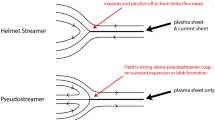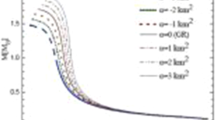Abstract
Neutron stars and black holes are the most compact astrophysical objects we can think of and as a consequence they are the main sources of gravitational waves. There are many astrophysically relevant scenarios in which these objects are immersed in or endowed with strong magnetic fields, in such a way that gravitational perturbations can couple to electromagnetic ones and can potentially trigger synergistic electromagnetic signatures. In a recent paper we derived the main equations for gravito-electromagnetic perturbations and studied in detail the case of polar electromagnetic perturbations driven by axial gravitational perturbations. In this paper we deal with the case of axial electromagnetic perturbations driven by polar black-hole or neutron stars oscillations, in which the energy emitted in case is considerably larger than in the previous case. In the case of neutron stars the phenomenon lasts considerably longer since the fluid acts as an energy reservoir that shakes the magnetic field for a timescale of the order of secs.








Similar content being viewed by others
References
Abbott, B.P., et al.: (The LIGO scientific collaboration) Rept. Prog. Phys. 72, 076901 (2009)
Accadia, T., et al.: (The Virgo Collaboration), Nuovo Cim. C034N06, 189 (2011)
Somiya, K., et al.: (KAGRA Collaboration) Class. Quant. Grav. 29, 124007 (2012)
Punturo, M., et al.: Class. Quant. Grav. 27, 194002 (2010)
Seoane, P.A., et al.: The eLISA Consortium (preprint). arXiv:1305.5720
Kawamura, S., et al.: Class. Quant. Grav. 28, 094011 (2011)
Manchester, R.N., et al.: The International Pulsar Timing Array (preprint). arXiv:1309.7392
Andersson, N., Kokkotas, K.D.: Mon. Not. R. Astron. Soc. 299, 1059 (1998)
Kokkotas, K.D., Apostolatos, T.A., Andersson, N.: Mon. Not. R. Astron. Soc. 320, 307 (2001)
Sotani, H., Kohri, K., Harada, T.: Phys. Rev. D 69, 084008 (2004)
Sotani, H., Yasutake, N., Maruyama, T., Tatsumi, T.: Phys. Rev. D 83, 024014 (2011)
Gaertig, E., Glampedakis, K., Kokkotas, K.D., Zink, B.: Phys. Rev. Lett. 107, 101102 (2011)
Sotani, H., Kokkotas, K.D.: Phys. Rev. D 70, 084026 (2004)
Sotani, H., Kokkotas, K.D.: Phys. Rev. D 71, 124038 (2005)
Sotani, H.: Phys. Rev. D 79, 064033 (2009)
Sotani, H.: Phys. Rev. D 80, 064035 (2009)
Yagi, K., Yunes, N., Tanaka, T.: Phys. Rev. Lett. 109, 251105 (2012)
Levin, Y.: Mon. Not. R. Astron. Soc. 377, 159 (2007)
Sotani, H., Kokkotas, K.D., Stergioulas, N.: Mon. Not. R. Astron. Soc. 375, 261 (2007)
Sotani, H., Kokkotas, K.D., Stergioulas, N.: Mon. Not. R. Astron. Soc. 385, L5 (2008)
Colaiuda, A., Beyer, H., Kokkotas, K.D.: Mon. Not. R. Astron. Soc. 396, 1441 (2009)
Cérda-Durán, P., Stergioulas, N., Font, J.A.: Mon. Not. R. Astron. Soc. 397, 1607 (2009)
Andersson, N., Glampedakis, K., Samuelsson, L.: Mon. Not. R. Astron. Soc. 396, 894 (2009)
Sotani, H.: Mon. Not. R. Astron. Soc. 417, L70 (2011)
van Hoven, M., Levin, Y.: Mon. Not. R. Astron. Soc 410, 1036 (2011)
Gabler, M., Cérda-Durán, P., Font, J.A., Müller, E., Stergioulas, N.: Mon. Not. R. Astron. Soc. 421, 2054 (2012)
Colaiuda, A., Kokkotas, K.D.: Mon. Not. R. Astron. Soc. 423, 811 (2012)
Sotani, H., Nakazato, K., Iida, K., Oyamatsu, K.: Phys. Rev. Lett. 108, 201101 (2012)
Sotani, H., Nakazato, K., Iida, K., Oyamatsu, K.: Mon. Not. R. Astron. Soc. 428, L21 (2013)
Sotani, H., Nakazato, K., Iida, K., Oyamatsu, K.: Mon. Not. R. Astron. Soc. 434, 2060 (2013)
van Hoven, M., Levin, Y.: Mon. Not. R. Astron. Soc 420, 3035 (2012)
Watts, A.L., Strohmayer, T.E.: Adv. Space Res. 40, 1446 (2006)
Abadie, J., et al.: Astrophys. J. 734, L35 (2011)
Palenzuela, C., Lehner, L., Liebling, S.L.: Science 329, 927 (2010)
Palenzuela, C., Garrett, T., Lehner, L., Liebling, S.L.: Phys. Rev. D 82, 044045 (2010)
Mösta, P., Palenzuela, C., Rezzolla, L., Lehner, L., Yoshida, S., Pollney, D.: Phys. Rev. D 81, 064017 (2010)
Alic, D., Moesta, P., Rezzolla, L., Zanotti, O., Jaramillo, J.L.: Astrophys. J. 754, 36 (2012)
Lehner, L., Palenzuela, C., Liebling, S.L., Thompson, C., Hanna, C.: Phys. Rev. D 86, 104035 (2012)
Dionysopoulou, K., Alic, D., Palenzuela, C., Rezzolla, L., Giacomazzo, B.: Phys. Rev. D 88, 044020 (2013)
Palenzuela, C., Lehner, L., Ponce, M., Liebling, S.L., Anderson, M., Neilsen, D., Motl, P.: Phys. Rev. Lett. 111, 061105 (2013)
Palenzuela, C., Lehner, L., Liebling, S.L., Ponce, M., Anderson, M., Neilsen, D., Motl, P.: Phys. Rev. D 88, 043011 (2013)
Rezzolla, L., Giacomazzo, B., Baiotti, L., Granot, J., Kouveliotou, C., Aloy, M.A.: Astrophys. J. 732, L6 (2011)
Paschalidis, V., Etienne, Z.B., Shapiro, S.L.: Phys. Rev. D 88, 021504(R) (2013)
Tanaka, M., Hotokezaka, K.: Astrophys. J. 775, 113 (2013)
Hotokezaka,K., Kyutoku, K., Tanaka, M., Kiuchi, K., Sekiguchi, Y., Shibata, M., Wanajo, S.: Astrophys. J. 778, L16 (2013)
Sotani, H., Kokkotas, K.D., Laguna, P., Sopuerta, C.F.: Phys. Rev. D 87, 084018 (2013)
Kouretsis, A.P., Tsagas, C.G.: Phys. Rev. D 88, 044006 (2013)
Schutz, B.F.: Introduction to General Relativity. Cambridge University Press, Cambridge (1985)
Wasserman, I., Shapiro, S.L.: Astrophys. J. 265, 1036 (1983)
Tchekhovskoy, A., Narayan, R., McKinney, J.C.: Mon. Not. R. Astron. Soc. 418, L79 (2011)
McKinney, J.C., Tchekhovskoy, A., Blandford, R.D.: Mon. Not. R. Astron. Soc. 423, 3083 (2012)
Sotani, H., Saijo, M.: Phys. Rev. D 74, 024001 (2006)
Teukolsky, S.A.: Phys. Rev. D 61, 087501 (2000)
Cunningham, C.M., Price, R.H., Moncrief, V.: Astrophys. J. 224, 643 (1978)
Cunningham, C.M., Price, R.H., Moncrief, V.: Astrophys. J. 230, 870 (1979)
Woan, G.: A very low frequency radio telescope on the far side of the Moon. In: Measuring the Size of Things in the Universe: HBT Interferometry and Heavy Ion Physics, p. 347 (1999)
Kondo, T., Kawano, N.: Low Frequency Obs on the Moon. Technical report, National Astronomical Observatory of Japan (1999)
Allen, G., Andersson, N., Kokkotas, K.D., Schutz, B.F.: Rhys. Rev. D 58, 124012 (1998)
Thorne, K.S.: Astrophys. J. 158, 997 (1969)
Gaertig, E., Kokkotas, K.D.: Phys. Rev. D 83, 064031 (2011)
Kokkotas, K.D., Schutz, B.F.: Mon. Not. R. Astron. Soc. 255, 119 (1992)
Acknowledgments
H.S. is grateful to Y. Sekiguchi for valuable comments. H.S., K.K., and P.L. acknowledge the support and hospitality of the YITP (Kyoto) during the workshop “YKIS2013”, where a significant part of the work has been done. This work was supported by the German Science Foundation (DFG) via SFB/TR7, by Grants-in-Aid for Scientific Research on Innovative Areas through No. 24105001, and No. 24105008 provided by MEXT, by Grant-in-Aid for Young Scientists (B) through No. 24740177 provided by JSPS, by the Yukawa International Program for Quark-hadron Sciences, and by the Grant-in-Aid for the global COE program “The Next Generation of Physics, Spun from Universality and Emergence” from MEXT. P.L. is supported by NSF grants 1205864, 1205864, 0903973, 0855423. C.F.S. is supported by contracts AYA-2010-15709 and FIS2011-30145-C03-03 of the Spanish Ministry of Science and Innovation, and contract 2009-SGR-935 of AGAUR (Generalitat de Catalunya).
Author information
Authors and Affiliations
Corresponding author
Appendix
Appendix
In this appendix, we present the perturbation equations for gravitational and electromagnetic waves adopted in this paper. More details can be found in Paper I [46]. Using the well-known Regge-Wheeler gauge, the metric perturbations, \(h_{\mu \nu }\), with polar parity can be decomposed into tensor spherical harmonics as
where \(H_{0,lm}, H_{1,lm}, H_{2,lm}\), and \(K_{lm}\) are functions of \(t\) and \(r\) only, and \(Y_{lm}=Y_{lm}(\theta ,\phi )\) denotes the scalar spherical harmonics on the \(2-\)sphere. On the other hand, the tensor harmonic expansion for the “magnetic” multipoles (or axial parity) of the electromagnetic perturbations, \(f_{\mu \nu }\), is given by
where \(f_{02}^\mathrm{(M)}, f_{12}^\mathrm{(M)}\), and \(f_{23}^\mathrm{(M)}\) are also functions of \(t\) and \(r\) only.
1.1 Neutron-star background
For the perturbations around the neutron star background, we adopt the formalism derived by Allen et al. [58], where the perturbations are described by three coupled wave-type equations, i.e., two equations describe the perturbations of the spacetime and the other one describes the fluid perturbations. In addition to the three wave equations, there is also a constraint equation. The two wave equations for the spacetime variables are
where \(r_*\) is the tortoise coordinate defined as \(\partial _{r_*} =e^{(\nu -\lambda )/2}\partial _r\), \(n \equiv (l-1)(l+2)/2\), \(C_s\) is the fluid sound speed, and \(F_{lm}\), \(S_{lm}\), and \(H_{lm}\) are given by
On the other hand, the wave equation for the perturbations of the relativistic enthalpy, \(H_{lm}\), describing the fluid perturbations, is
This third wave equation is valid only inside the star. On the other hand, the first two wave equations are simplified considerably outside the star, and they can be reduced to a single wave equation, i.e., the Zerilli equation (see [58] and §4.2). Finally, the Hamiltonian constraint,
can be used for setting up initial data and monitoring the evolution of the coupled system.
Finally, the perturbation equation for the “magnetic-type” (axial) electromagnetic perturbations outside the neutron star is
where \(\Phi _{lm} \equiv f_{23,lm}^\mathrm{(M)}\) and
1.2 Black-hole background
The “magnetic-type” (axial) electromagnetic perturbations driven by the gravitational perturbations on a black hole background are also governed by the same equation as the one derived for the exterior region of neutron stars [see Eq. (17)], that is
The source term of this wave equation, \(\mathcal{S}_{20}^{(\mathrm M)}\), has the same form as in Eq. (18). On the other hand, and is well-known, the spacetime metric perturbations are described by a single equation, the Zerilli equation
In the same way as in the case of the neutron star background, one can also adopt \(F_{lm}\) and \(S_{lm}\) as the perturbation variables for the spacetime oscillations. Actually, one can obtain the variables \(F_{lm}\) and \(S_{lm}\) from the Zerilli function \(Z_{lm}\) using the following expressions:
Rights and permissions
About this article
Cite this article
Sotani, H., Kokkotas, K.D., Laguna, P. et al. Electromagnetic waves from neutron stars and black holes driven by polar gravitational perturbations. Gen Relativ Gravit 46, 1675 (2014). https://doi.org/10.1007/s10714-014-1675-5
Received:
Accepted:
Published:
DOI: https://doi.org/10.1007/s10714-014-1675-5




